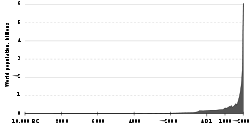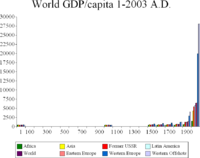
I PAT
Encyclopedia
I = PAT is the lettering of a formula put forward to describe the impact of human activity on the environment
.
In words:
The equation was developed in the 1970s during the course of a debate between Barry Commoner
, Paul R. Ehrlich
and John Holdren
. Commoner argued that environmental impacts in the United States were caused primarily by changes in its production technology following World War II
, while Ehrlich and Holdren argued that all three factors were important and emphasized in particular the role of population growth. (PR Ehrlich, JP Holdren, Impact of population growth, Science
, 1971).
The equation can aid in understanding some of the factors affecting human impacts on the environment.
 In the I=PAT equation, the variable P represents the population of an area, such as the world. Since the rise of industrial societies, human population has been increasing exponentially. This has caused Thomas Malthus
In the I=PAT equation, the variable P represents the population of an area, such as the world. Since the rise of industrial societies, human population has been increasing exponentially. This has caused Thomas Malthus
and many others to postulate that this growth would continue until checked by widespread hunger and famine (see Malthusian growth model
).
The United Nations and the US Census Bureau project that world population will increase from 6.8 billion today to about 9.2 billion by 2050.
These projections take into consideration that population growth has slowed in recent years as women are having fewer children. This phenomenon is believed to be a result of demographic transition
in developed nations. As a result, the UN believes that human population might stabilize around 9 billion by 2100. However, since the world population is set to keep rising for the next few decades, this factor of the I=PAT equation will likely keep increasing human impact on the environment for the near future.
 The variable A, in the I=PAT equation stands for affluence. It represents the average consumption of each person in the population. As the consumption of each person increases, the total environmental impact increases as well. A common proxy for measuring consumption is through GDP per capita. While GDP per capita measures production, it is often assumed that consumption increases when production increases. GDP per capita has been rising steadily over the last few centuries and is driving up human impact in the I=PAT equation.
The variable A, in the I=PAT equation stands for affluence. It represents the average consumption of each person in the population. As the consumption of each person increases, the total environmental impact increases as well. A common proxy for measuring consumption is through GDP per capita. While GDP per capita measures production, it is often assumed that consumption increases when production increases. GDP per capita has been rising steadily over the last few centuries and is driving up human impact in the I=PAT equation.
then the more cars per capita, the greater the impact.
Since the ecological impacts of each product are so far reaching, increases in consumption quickly result in large impacts on the environment.
has shown that T has decreased and that it is likely to continue to do so in the future. However, since P has increased exponentially, and A has also increased drastically, the overall environmental impact, I, has still increased.
Environment (biophysical)
The biophysical environment is the combined modeling of the physical environment and the biological life forms within the environment, and includes all variables, parameters as well as conditions and modes inside the Earth's biosphere. The biophysical environment can be divided into two categories:...
.
- I = P × A × T
In words:
- Human Impact (I) on the environment equals the product of P= Population, A= Affluence, T= Technology. This describes how our growing population, affluence, and technology contribute toward our environmental impact.
The equation was developed in the 1970s during the course of a debate between Barry Commoner
Barry Commoner
Barry Commoner is an American biologist, college professor, and eco-socialist. He ran for president of the United States in the 1980 US presidential election on the Citizens Party ticket. He was also editor of Science Illustrated magazine.-Biography:Commoner was born in Brooklyn...
, Paul R. Ehrlich
Paul R. Ehrlich
Paul Ralph Ehrlich is an American biologist and educator who is the Bing Professor of Population Studies in the department of Biological Sciences at Stanford University and president of Stanford's Center for Conservation Biology. By training he is an entomologist specializing in Lepidoptera , but...
and John Holdren
John Holdren
John Paul Holdren is advisor to President Barack Obama for Science and Technology, Director of the White House Office of Science and Technology Policy, and Co-Chair of the President’s Council of Advisors on Science and Technology...
. Commoner argued that environmental impacts in the United States were caused primarily by changes in its production technology following World War II
World War II
World War II, or the Second World War , was a global conflict lasting from 1939 to 1945, involving most of the world's nations—including all of the great powers—eventually forming two opposing military alliances: the Allies and the Axis...
, while Ehrlich and Holdren argued that all three factors were important and emphasized in particular the role of population growth. (PR Ehrlich, JP Holdren, Impact of population growth, Science
Science (journal)
Science is the academic journal of the American Association for the Advancement of Science and is one of the world's top scientific journals....
, 1971).
The equation can aid in understanding some of the factors affecting human impacts on the environment.
Population

Thomas Malthus
The Reverend Thomas Robert Malthus FRS was an English scholar, influential in political economy and demography. Malthus popularized the economic theory of rent....
and many others to postulate that this growth would continue until checked by widespread hunger and famine (see Malthusian growth model
Malthusian growth model
The Malthusian growth model, sometimes called the simple exponential growth model, is essentially exponential growth based on a constant rate of compound interest...
).
The United Nations and the US Census Bureau project that world population will increase from 6.8 billion today to about 9.2 billion by 2050.
These projections take into consideration that population growth has slowed in recent years as women are having fewer children. This phenomenon is believed to be a result of demographic transition
Demographic transition
The demographic transition model is the transition from high birth and death rates to low birth and death rates as a country develops from a pre-industrial to an industrialized economic system. The theory is based on an interpretation of demographic history developed in 1929 by the American...
in developed nations. As a result, the UN believes that human population might stabilize around 9 billion by 2100. However, since the world population is set to keep rising for the next few decades, this factor of the I=PAT equation will likely keep increasing human impact on the environment for the near future.
Environmental Impacts
Increased population increases our environmental impact in many ways, which include but are not limited to:- Increased land use - Results in habitat loss for other species.
- Increased resource use - Results in changes in land cover
- Increased pollution - Causes climate change, sickens people and damages ecosystems.
Affluence

Environmental Impacts
Increased consumption significantly increases human environmental impact. This is because each product consumed has wide ranging effects on the environment. For example, if the construction of a car had the following environmental impacts among others:- 605,664 gallons of water for parts and tires
- 682 lbs. of pollution at a mine for the lead battery.
- 2178 lbs. of discharge into water supply for the 22 lbs. of copper contained in the car.
then the more cars per capita, the greater the impact.
Since the ecological impacts of each product are so far reaching, increases in consumption quickly result in large impacts on the environment.
Technology
The T variable in the I=PAT equation represents how resource intensive the production of affluence is; how much environmental impact is involved in creating, transporting and disposing of the goods, services and amenities used. Improvements in efficiency can reduce resource intensiveness, reducing the T multiplier. Since technology can affect environmental impact in many different ways, the unit for T is often tailored for the situation I=PAT is being applied to. For example, for a situation where the human impact on climate change is being measured, an appropriate unit for T might be greenhouse gas emissions per unit of GDP.Environmental Impacts
Increases in efficiency can reduce overall environmental impact. However, with P increasing exponentially, T would have to decrease drastically (doubling efficiency each time the population doubles) just to maintain the same impact with the same affluence. Over the last few years, data from the World BankWorld Bank
The World Bank is an international financial institution that provides loans to developing countries for capital programmes.The World Bank's official goal is the reduction of poverty...
has shown that T has decreased and that it is likely to continue to do so in the future. However, since P has increased exponentially, and A has also increased drastically, the overall environmental impact, I, has still increased.
See also
- Affluence
- Carbon footprintCarbon footprintA carbon footprint has historically been defined as "the total set of greenhouse gas emissions caused by an organization, event, product or person.". However, calculating a carbon footprint which conforms to this definition is often impracticable due to the large amount of data required, which is...
- Ecological footprintEcological footprintThe ecological footprint is a measure of human demand on the Earth's ecosystems. It is a standardized measure of demand for natural capital that may be contrasted with the planet's ecological capacity to regenerate. It represents the amount of biologically productive land and sea area necessary to...
- Ecological indicatorEcological indicatorEcological indicators are used to communicate information about ecosystems and the impact human activity has on ecosystems to groups such as the public or government policy makers. Ecosystems are complex and ecological indicators can help describe them in simpler terms that can be understood and...
- Embodied energyEmbodied energyEmbodied energy is defined as the sum of energy inputs that was used in the work to make any product, from the point of extraction and refining materials, bringing it to market, and disposal / re-purposing of it...
- Life cycle assessmentLife cycle assessmentA life-cycle assessment is a technique to assess environmental impacts associated with all the stages of a product's life from-cradle-to-grave A life-cycle assessment (LCA, also known as life-cycle analysis, ecobalance, and cradle-to-grave analysis) is a technique to assess environmental impacts...
- Sustainability measurementSustainability measurementSustainability measurement is a term that denotes the measurements used as the quantitative basis for the informed management of sustainability...
- TechnologyTechnologyTechnology is the making, usage, and knowledge of tools, machines, techniques, crafts, systems or methods of organization in order to solve a problem or perform a specific function. It can also refer to the collection of such tools, machinery, and procedures. The word technology comes ;...
- Water footprintWater footprintThe water footprint of an individual, community or business is defined as the total volume of freshwater used to produce the goods and services consumed by the individual or community or produced by the business. Water use is measured in water volume consumed and/or polluted per unit of time. A...

